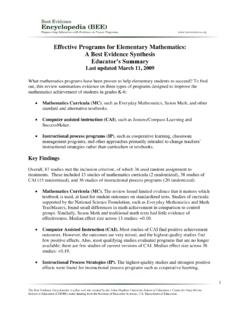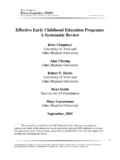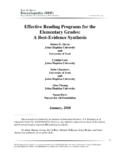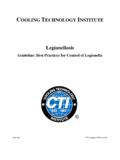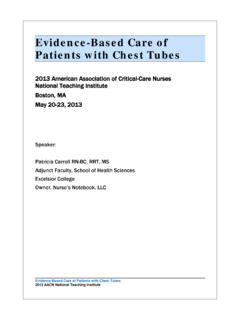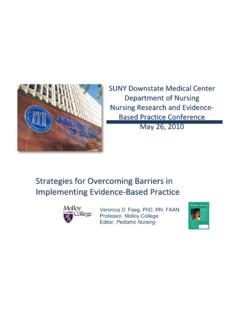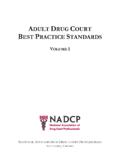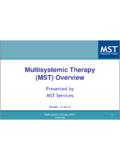Transcription of Effective Beginning Reading Programs: A Best …
1 The best evidence Encyclopedia is a free web site created by the Johns Hopkins University School of Education s Center for Data-Driven Reform in Education (CDDRE) under funding from the institute of Education Sciences, Department of Education. 1 Effective Beginning Reading Programs: A best - evidence Synthesis Robert E. Slavin Johns Hopkins University -and- University of York Cynthia Lake Johns Hopkins University Bette Chambers University of York Alan Cheung Johns Hopkins University Susan Davis Success for All Foundation June, 2009 _____ This research was funded by the institute of Education Sciences, Department of Education (Grant No. R305A040082). However, any opinions expressed are those of the authors and do not necessarily represent IES positions or policies. We thank Marilyn Adams, Steven Ross, Michael McKenna, and Nancy Madden for comments on an earlier draft. The best evidence Encyclopedia is a free web site created by the Johns Hopkins University School of Education s Center for Data-Driven Reform in Education (CDDRE) under funding from the institute of Education Sciences, Department of Education.
2 2 Abstract This article systematically reviews research on the achievement outcomes of four types of approaches to improving the Beginning Reading success of children in kindergarten and first grade: Reading curricula, instructional technology, instructional process programs, and combinations of curricula and instructional process. Study inclusion criteria included use of randomized or matched control groups, a study duration of at least 12 weeks, valid achievement measures independent of the experimental treatments, and a final assessment at the end of grade 1 or later. A total of 63 studies met these criteria. The review concludes that instructional process programs designed to change daily teaching practices have substantially greater research support than programs that focus on curriculum or technology alone. In particular, positive achievement effects were found for Success for All, PALS, phonological awareness training, and other programs focused on professional development.
3 The best evidence Encyclopedia is a free web site created by the Johns Hopkins University School of Education s Center for Data-Driven Reform in Education (CDDRE) under funding from the institute of Education Sciences, Department of Education. 3 From the first day of kindergarten to the last day of first grade, most children go through an extraordinary transformation as readers. If all goes well, children at the end of first grade know the sounds of all the letters and can form them into words, know the most common sight words, and can read and comprehend simple texts. The K-1 period is distinct from other stages of Reading development because during this stage, children are learning all the basic skills of turning print into meaning. From second grade on, children build fluency, comprehension, and vocabulary for Reading ever more complex text in many genres, but the K-1 period is qualitatively different in its focus on basic skills.
4 Success in Beginning Reading is a key prerequisite for success in Reading in the later years. Longitudinal studies ( , Juel, 1988) have shown that children with poor Reading skills at the end of first grade are unlikely to catch up later on, and are likely to have difficulties in Reading throughout their schooling. It is in the early elementary grades where the gap in performance between children of different races first appears, and this gap is perhaps the most important policy issue in education in the On the fourth grade National Assessment of Educational Progress (NAEP, 2007), 43% of White children achieved at the proficient level on the National Assessment of Educational Progress, but only 14% of African American, 17% of Hispanic, and 8% of American Indian children scored at this level. Effective Beginning Reading programs are important for children of all backgrounds, but for disadvantaged and minority children and for children with learning disabilities, who particularly depend on school to achieve success, Effective Beginning Reading programs are especially important.
5 In recent years, there has been a shift in policy and practice toward more of a focus on phonics and phonemic awareness in Beginning Reading instruction. Based in large part on the findings of the National Reading Panel (2000) and earlier research syntheses, the Bush The best evidence Encyclopedia is a free web site created by the Johns Hopkins University School of Education s Center for Data-Driven Reform in Education (CDDRE) under funding from the institute of Education Sciences, Department of Education. 4 Administration s Reading First program strongly favored phonics and phonemic awareness, and a national study of Reading First by Gamse et al. (2008) and Moss et al. (2008) found that teachers in Reading First schools were in fact doing more phonics teaching than were those in similar non- Reading First schools. Yet outcomes were disappointing, with small effects seen on first grade decoding measures and no impact on comprehension measures in grades 1-3.
6 Similarly, a large study of intensive professional development focusing on phonics found no effects on the Reading skills of second graders (Garet et al., 2008). The findings of these large-scale experiments imply that while the importance of phonics and phonemic awareness in Beginning Reading instruction are well established, the addition of phonics to traditional basal instruction is not sufficient to bring about widespread improvement in children s Reading . Other factors, especially relating to the quality of instruction, are also consequential. Because of the great importance of this stage of development, there have been several reviews of research on Beginning Reading . Adams (1990) wrote an influential review, which concluded among other things that systematic phonics should be central to early Reading instruction. Reviews by Snow, Burns, & Griffin (1998), by the National Reading Panel (NRP, 2000), by Torgerson, Brooks, & Hall (2006), and by the Rose Report in the (Rose, 2006) have reinforced the importance of phonics.
7 The National Reading Panel (2000) pointed to five factors needed for success in early Reading : phonemic awareness, phonics, fluency, vocabulary, and comprehension. These reviews, however, focused on variables associated with positive outcomes in Beginning Reading rather than on specific Reading programs. The What Works Clearinghouse (2009), in its Beginning Reading topic report, reviewed research on Reading programs evaluated in grades K-3. However, the WWC only reports program ratings, and does not include discussion of the findings or draw generalizations about the effects of types of The best evidence Encyclopedia is a free web site created by the Johns Hopkins University School of Education s Center for Data-Driven Reform in Education (CDDRE) under funding from the institute of Education Sciences, Department of Education. 5 programs. Further, WWC inclusion standards applied in its Beginning Reading topic report include very brief studies (as few as 5 hours of instruction), very small studies (as few as 46 students), and measures of skills taught in experimental but not control groups (see Slavin, 2008).
8 The Torgerson et al. (2006) review only included 12 randomized evaluations contrasting phonetic and non-phonetic approaches, but most of these were also brief (most provided 5 hours or less of instruction), had very small sample sizes, often used measures of objectives not taught at all in the control group, and were mostly supplementary rather than core approaches. The present article reviews research on the achievement outcomes of practical initial (non-remedial) Beginning Reading programs for all children, applying consistent methodological standards to the research. It is intended to provide fair summaries of the achievement effects of the full range of Beginning Reading approaches available to educators and policy makers, and to summarize for researchers the current state of the art in this area. The scope of the review includes all types of programs that teachers, principals, or superintendents might consider to improve the success of their children in Beginning Reading : curricula, instructional technology, instructional process programs, and combinations of curricula and instructional process.
9 The review uses a form of best evidence synthesis (Slavin, 1986), adapted for use in reviewing what works literatures in which there are generally few studies evaluating each of many programs (see Slavin, 2008). It is part of a series, all of which used the same methods, with minor adaptations. Separate research syntheses review research on remedial, preventive, and special education programs in elementary Reading (Slavin, Lake, Davis, & Madden, 2009), upper-elementary programs (Slavin, Lake, Cheung, & Davis, 2008), middle and high school Reading programs (Slavin, Cheung, Groff, & Lake, 2008), and Reading programs for English language learners (Cheung & Slavin, 2005). The best evidence Encyclopedia is a free web site created by the Johns Hopkins University School of Education s Center for Data-Driven Reform in Education (CDDRE) under funding from the institute of Education Sciences, Department of Education. 6 The syntheses of upper-elementary Reading programs (Slavin et al.)
10 , 2008a) and middle and high school Reading programs (Slavin et al., 2008b) provide the closest background for the present review. The upper-elementary Reading review identified 77 studies that met the inclusion standards. These were divided into four categories: Reading curricula (core and supplementary textbooks), instructional technology, instructional process programs (such as cooperative learning), and combinations of curricula and instructional process. Effect sizes for curricula (ES=+ ) and for instructional technology (ES=+ ) were very low. Larger effect sizes (ES=+ ) were found for instructional process programs, especially cooperative learning programs in which students help one another master Reading comprehension skills in small teams or pairs. The sample-size weighted mean effect size for cooperative learning methods, specifically Cooperative Integrated Reading and Composition (CIRC) and Peer Assisted Learning Strategies (PALS), was + The secondary review covered grades 6-12, with most studies focused on grades 6-9.


